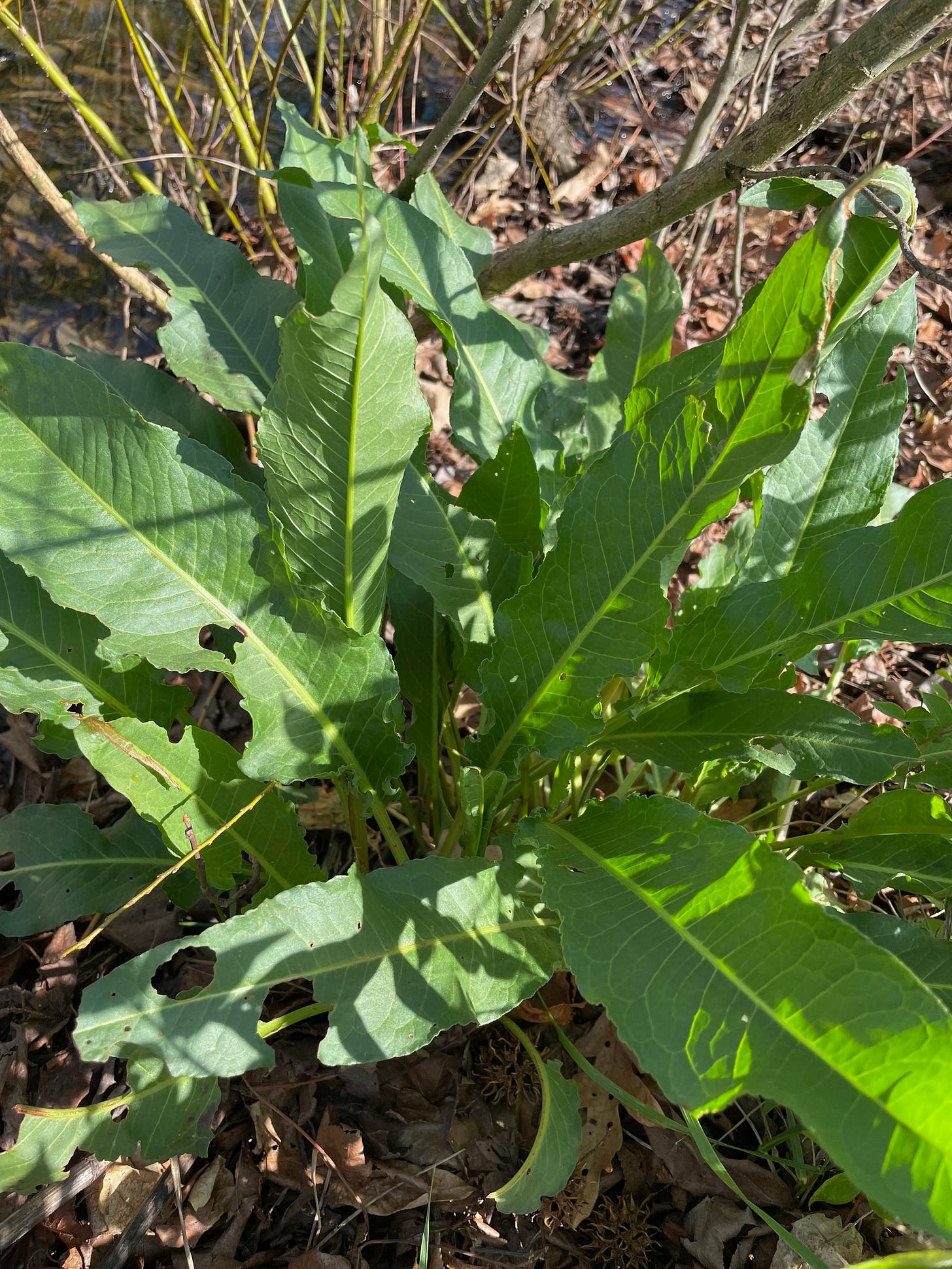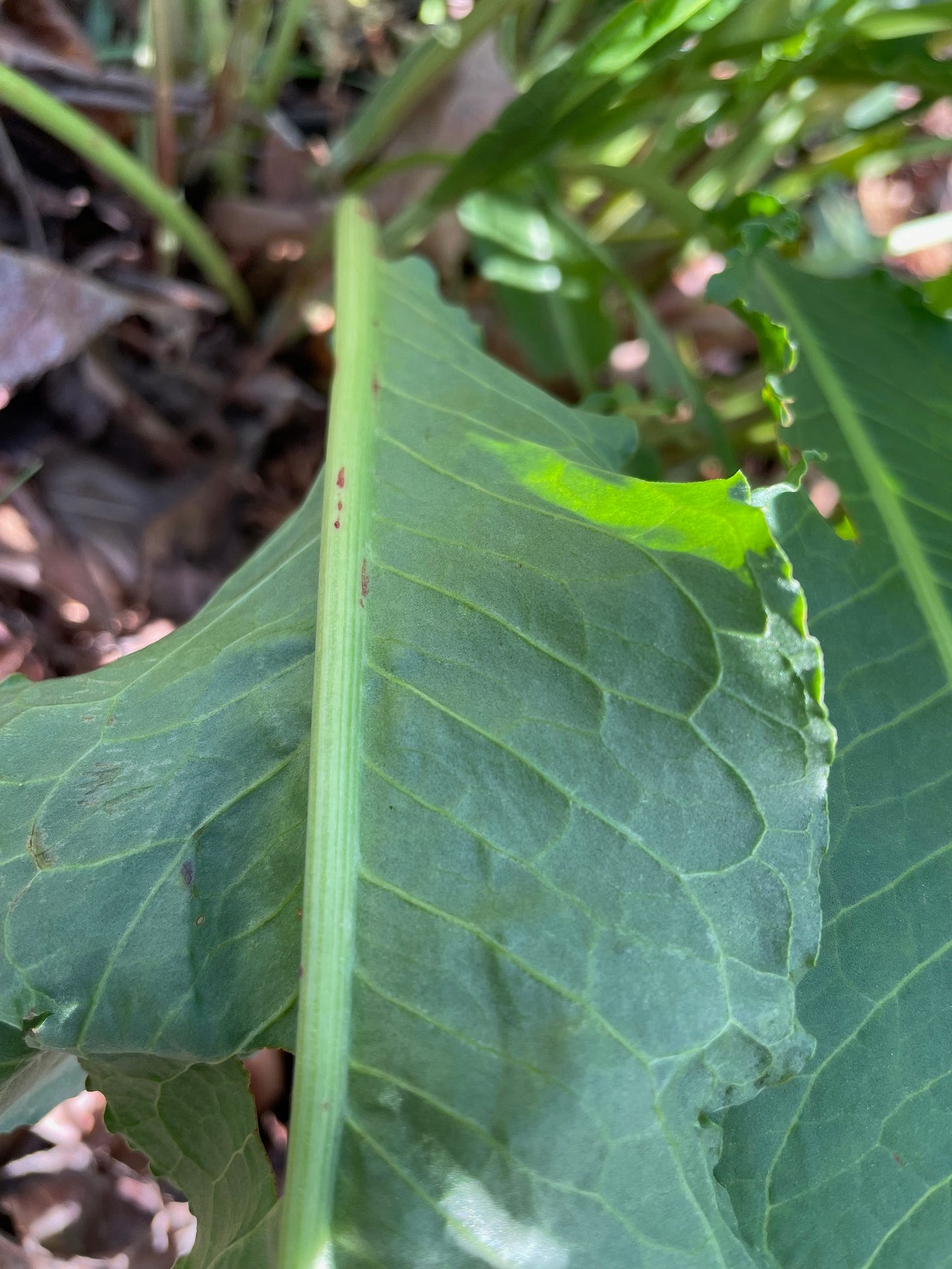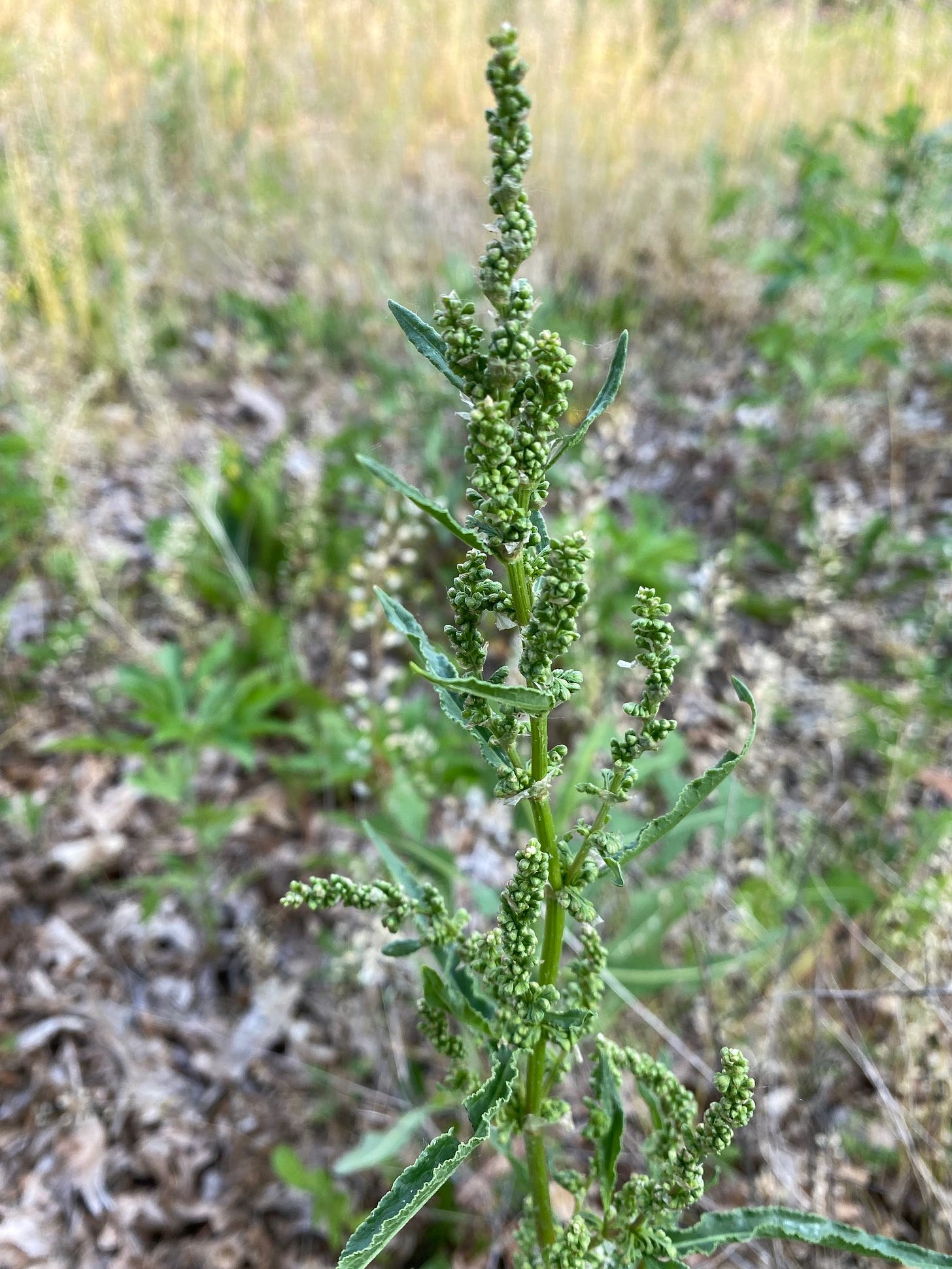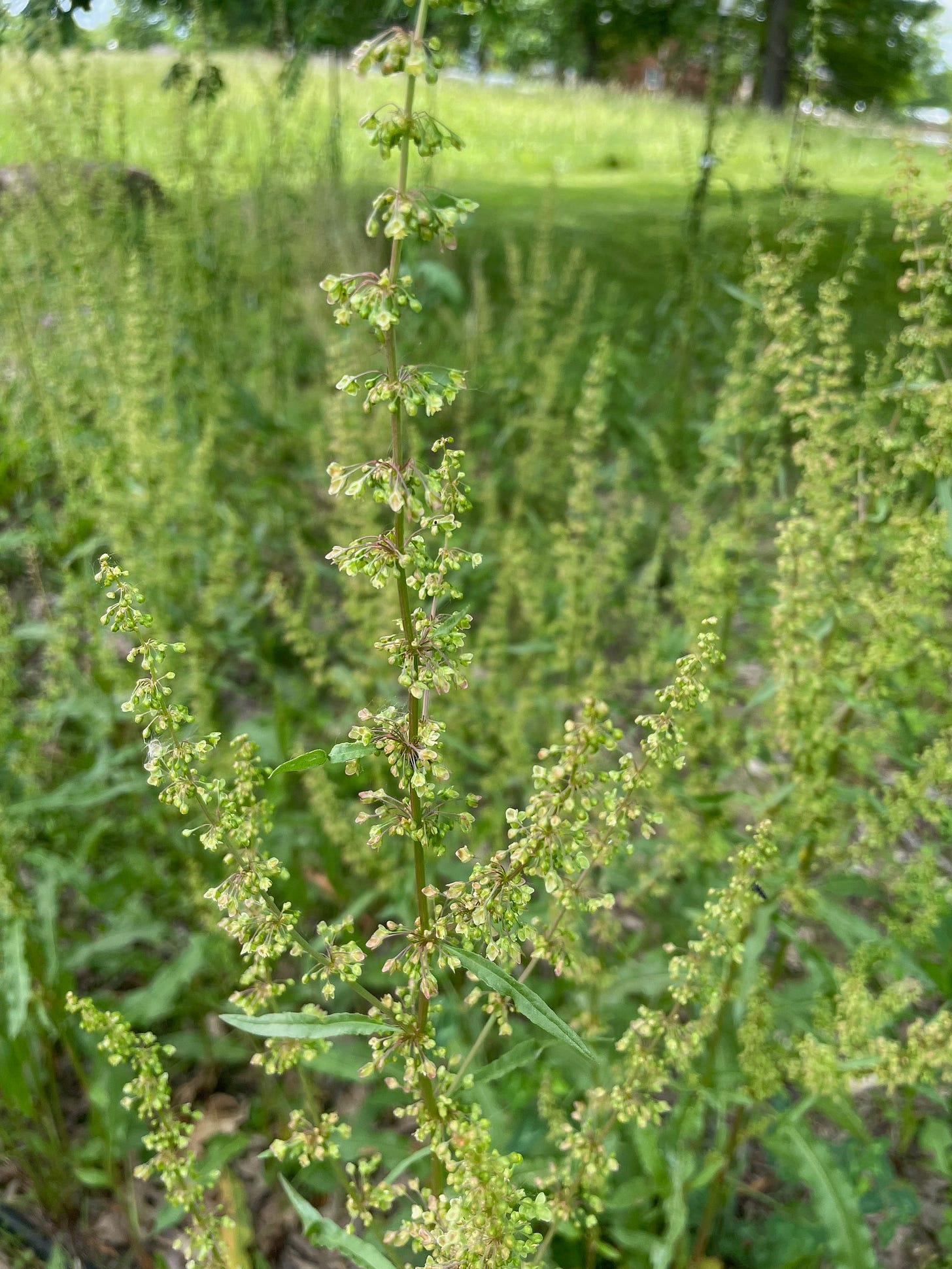Yellow Dock
Springtime at Weedom produces plentiful yellow dock in a state acceptable for for both food and medicine. This time of year, the stems and leaves can be cooked and eaten, while the roots can be chopped and either dried or tinctured for use an astringent, nutritive, digestive aid, liver tonic, etc. Late in Summer or early Fall, the seeds turn brown and can be used as a coffee substitute, or ground into a flour and used, in combination with other grains, for breads and crackers.
Spot yellow dock most easily by looking for the red/brown stems with seeds that often stand through the winter, and then remember the location. Around these old stems, there will be plenty of rosettes of new or second year plants emerging as soon as the weather warms up.
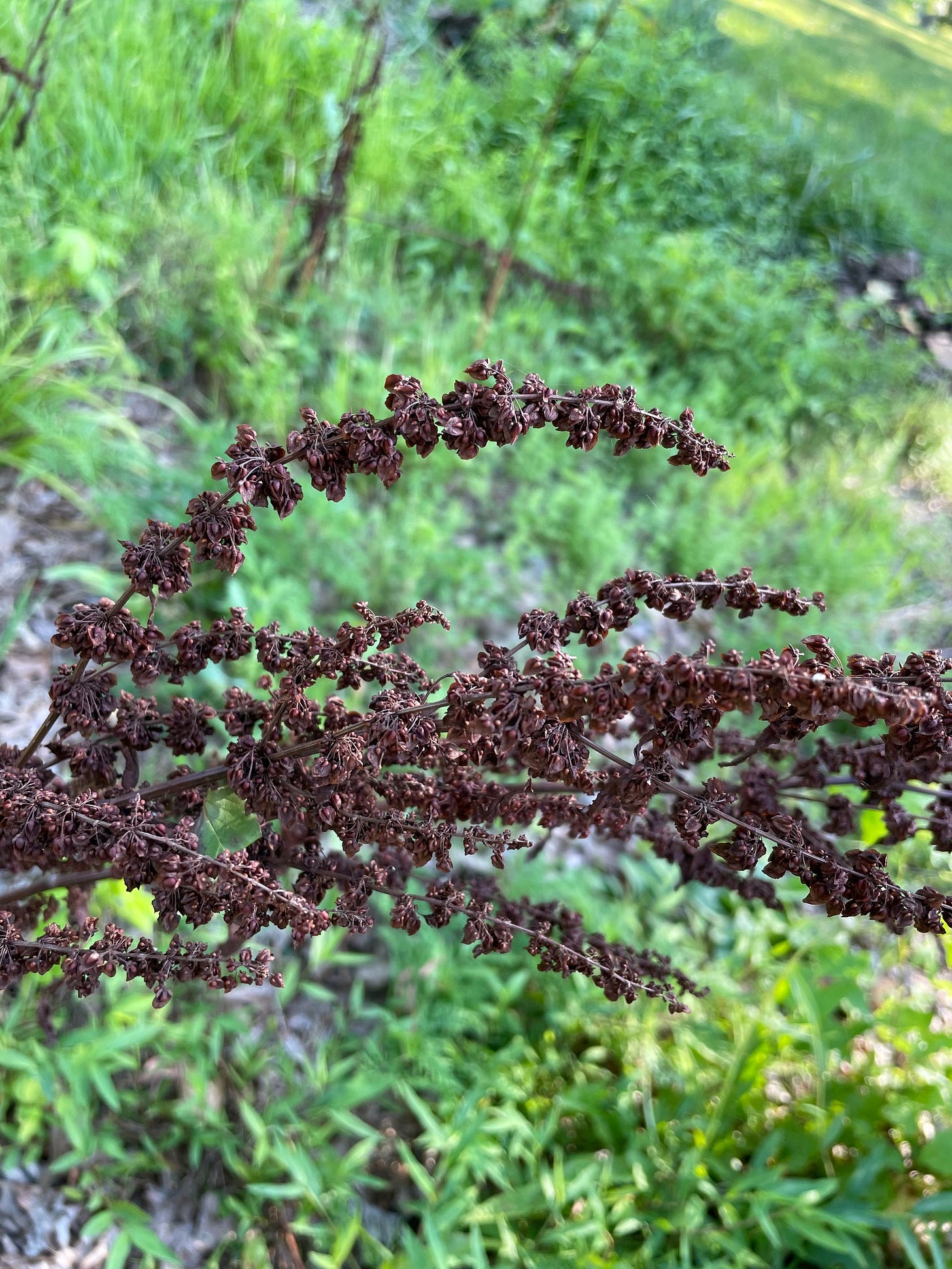
Yellow dock, Rumex crispus, of the buckwheat family, Polygonaceae, has been imported from Eurasia to N. America, (and just about everywhere else in the world). It promptly spread by means of its copious seeds, which can survive for 50-80 years in the ground. Don’t worry about running out of this fine herbal gift if you have any at all. Though it seems to favor disturbed ground in USDA hardiness zones 4a to 9b, it can be found outside of those areas. Perennially arising from a large tap root, yellow dock has earned full weed honors by invading all 50 states of the U.S.. Young plants put up a single flowering stem while a fully mature plant will produce multiple stems up to 5 feet, (1.6 meters) high. This herb grows as deep as it does high, with a yellow taproot that can rival burdock’s, (up to 150 cm., (4.5 ft.) in length).
The following species of dock grow with similar habits in our region, but each has some fairly easily distinguishable features.
Yellow dock, Rumex crispus, also called curly dock, narrow dock or sour dock, has wavy basal leaves which tend to become more curled with age. The wings on its fruits have smooth edges. Inner flower sepals have pointed tips. This is the most widespread dock in the U.S. and the one most often eaten.
Rumex longifolius, yard dock, has less curly leaves, and inner flower sepals with rounded rather than pointed tips.
R. obtusifolius, bitter dock, has broader leaves with heart shaped bases and rounded tips. The wings on the fruit have sharp points on the edges.
For many uses, these dock plants overlap, but they certainly vary in their edibility and bitterness of the leaves. A mis-identification is definitely possible if you watch a single youtube vid, and go with it. (There’s a popular vid with bitter dock misidentified as the yellow (curly) dock, for example.)
The Rumex genus is generally divided into the docks, which have more bitter tasting leaves, and the sorrels, such as the much smaller Sheep sorrel, R. acetosella, with distinctly sour leaves. There are several other species of docks in N. America, most of which are not as edible as R. crispus.
Basal leaves of our yellow dock are 4-20 inches (10-50 cm.) in length with a prominent midvein, with a raised ridge down the center and with pinnate veins. The leaf edges undulate and become progressively curlier as they age. Leaf petioles can be range widely in length, are solid, with a D shaped cross section, and usually hairless. Stems of this plant have distinct ribs and swollen, jointed leaf nodes. Papery sheaths mark the alternating points where leaf petioles emerge from the stems.
Hundreds of greenish, non-showy flowers appear in late spring or early summer in branched racemes which occupy the upper half of each stem. Each flower has a very thin pedicel, 3 green tepals, 3 smaller tepals and no petals. Individual yellow dock plants bear both female flowers and bisexual flowers, which are wind pollinated. You can get a good close look at the fruits of this weed, and the seeds at the CES and Identify that Plant sites.
Depending on the reference, you’ll may be told that the leaves of yellow dock are edible raw, or that they must be boiled, drained, and boiled again in new water to get rid of the oxalic acid. This plant does have fairly high content of oxalic acid, particularly in the older leaves, and not a lot of calcium, (a high oxalate to calcium ratio) so that you won’t want to eat significant amounts of the leaves raw. It’s OK for most people to use very young spring leaves as a salad additive. The leaf stems, if peeled, can be eaten raw. If not peeled, you’ll want to cook them. It’s really a good idea to boil any larger or older leaves before eating much more than a nibble, because that process reduces the oxalic acid.
There are recipes for the seeds too. If you don’t mind the work of separating them from the outer chaff, the seeds can be ground into flour, and combined with other types of flour to make breads or crackers. Use the seeds only if they are mature and brown in color. Deane Jordan, of Eat the Weeds fame reports that 100 grams of Rumex crispus leaves supply 22 calories, 2 grams protein, 3 g of fiber, 4000 IU of vitamin A, 48 mg. vitamin C, 44 mg. calcium, 2.4 mg. iron, 89 mg. magnesium. Lisa Ganora (in Herbal Constituents) reports a study showing an average oxalic acid content of 620 mg/100 grams of leaves.
The roots below have been chopped up, and are now being tinctured in 1 : 2 (weight to volume) 70% ethanol in a little amber bottle.
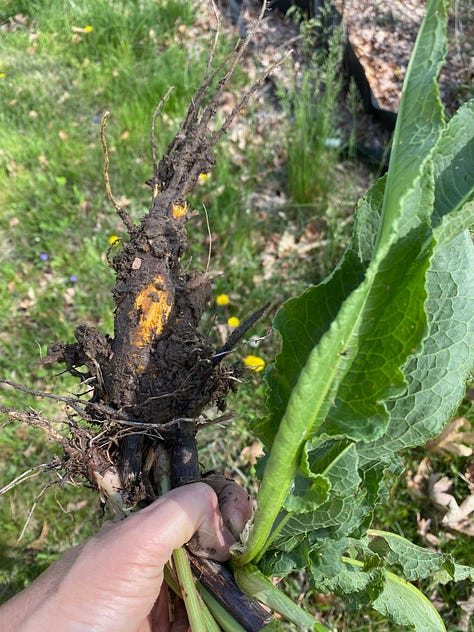
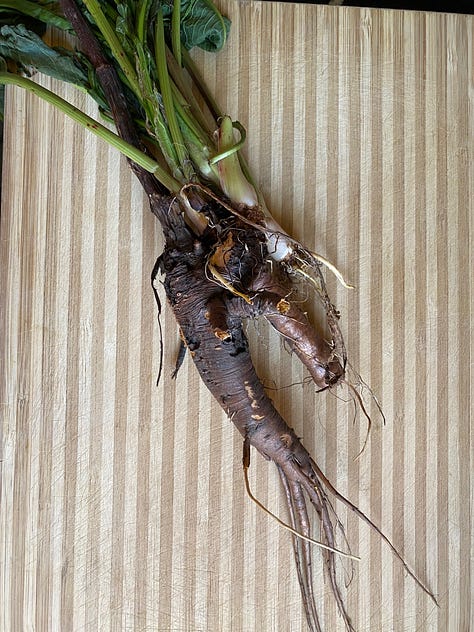
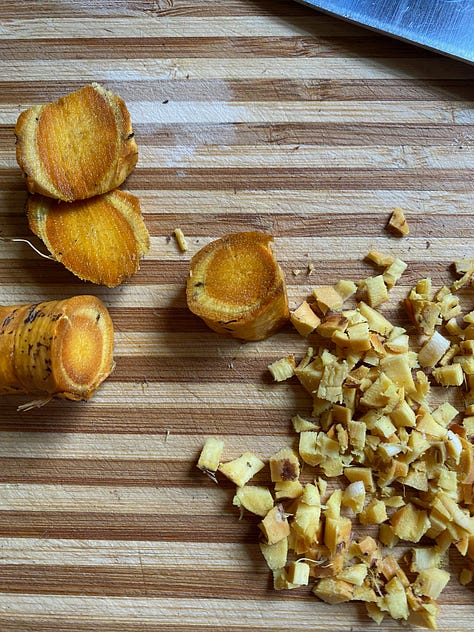
Prominent constituents of the medicinal roots are the tannins, providing astringent action, a good deal of carbohydrates and fiber, and a variety of anthraquinones and anthraquinone glycosides which lend their characteristic color to the root. The roots are a better source of magnesium than of iron, although they’re traditionally used to “build the blood” and correct anemia. Many herbalists conclude that the salutary, anti-inflammatory (cooling) effects of the roots on the G.I. tract assist in the absorption of iron from various other food sources. This explains the various formulas containing yellow dock root, which are used to address post-partum blood loss, and other types of anemia. Anthraquinones are blamed for the purgative effects of many strong laxative plants, but yellow dock is considered to be a relatively mild contributor of these compounds. Partly due to the opposing effects of tannins and fiber, and the presence of numerous antimicrobial constituents, this root is able to address both diarrhea and constipation, and has traditional use to treat dysentery. It’s also been applied to gastrointestinal inflammations such as Crohns disease, and to SIBO (small intestinal bacterial overgrowth).
The following anthraquinone compounds have been found in our yellow dock roots. They’re also found, and extensively studied in the related plants called Chinese rhubarb, (Rheum palmatum and/or Rheum officinale) which are very widely used in Traditional Chinese Medicine as anti-inflammatory, antifibrotic, anti-microbial and anti-cancer agents. You can therefore thank the Chinese for figuring out many of the possible reasons that yellow dock root continues strongly in medicinal applications.
emodin - also found in the outer leaf rinds of aloe. Exhibits numerous antiproliferative and cytotoxic mechanisms of tumor suppression, (such as collegenase inhibition for 1 example), smooth muscle relaxant, CNS depressant in fairly large doses, COX 2 inhibition and other suppression of inflammatory pain, styptic, purgative, antiseptic, antiviral, trichomonicide.
chrysophanol- antibacterial, antifungal, pesticide. calcium antagonist (smooth muscle relaxant), hemostat.
rhein (4,5-dihydroxyanthraquinone-2-carboxylic acid) - anti-inflammatory, liver protectant connective tissue protectant, kidney protectant, anti-diabetic, and anti-cancer, all by numerous mechanisms.
chrysophanic acid -antifungal, antispasmodic, calcium antagonist, smooth muscle relaxant,
physcion (1,8-dihydroxy-3-methoxy-6-methylanthraquinone) used or studied for everything from fungicide and pesticide to antitumor, anti-inflammatory, antimicrobial, and treatment for atopic dermatitis.
Medicinally, the scientifically neglected yellow dock itself, is not well supported by human clinical trials. Such studies would not certainly lead to profit for any investor. This weed is far too ubiquitous, and finding “acceptible evidence” of its efficacy would be like making half of big pharma’s creations available over the counter for bottom dollar, generic prices. Therefore you’ll find herbalists citing their own experiences, and those of other colleagues, rather than double blinded studies in people. It’s all case reports. Imagine what would happen if Matthew Wood’s anecdote about the dramatic response of his client with Crohn’s symptoms led to numerous other people skipping their ostomy surgery, and remaining well thereafter. Could be dangerous.
Leaves of yellow dock have been crushed and applied topically to allay the discomfort of encounters with stinging nettles, and other irritants. The roots are used both internally and externally on various forms of dermatitis. The liver supporting effects of the root are credited with much of the effectiveness on external skin disorders, and even inflammatory pain, as toxins are more efficiently broken down in a healthier liver, rather than accumulating throughout the body, or eliminated via the skin.
Though this herb can stimulate bile flow, the time to take it is Not when you have acute gall bladder disease caused by stones. It’s likely to make the misery much worse in an acute ‘gall bladder attack’. Yellow dock is a supportive treatment. Other caveats: Those with propensity for kidney stones should find different greens to eat. Fresh root has more of a possibility of causing vomiting than the dried root.
Suggested doses in the British Herbal Pharmacopoeia are 2-4 grams of dried root, or 1-2 ml of a tincture 1:5 weight to volume in 45% ethanol taken 3 times daily. An aqueaous decoction can be made with 1 or 2 teaspoons of root per cup of water, simmered for 15 min, and 1 cupful consumed 3 times a day. Consider soaking dried roots in apple cider vinegar for a few weeks, then straining this and using the liquid as a tonic to help you to assimilate more iron from the spinach and greens in your salads. Let us know if you’ve had some interesting experiences or have questions about our weed of the week!
Where We Dig
1. CABI. Rumex crispus (curled dock). CABI Compendium. 2021;CABI Compendium:48059. doi:10.1079/cabicompendium.48059
2. DerMarderosian A, Buetler J. Review of Natural Products. 8th edition. Lippincott Williams & Wilkins; Facts and Comparisons; 2014. https://openlibrary.org/books/OL27960482M/Review_of_Natural_Products
3. Ganora L. Herbal Constituents, 2nd Edition - Foundations of Phytochemistry. Lulu Press, Inc.; 2021. https://openlibrary.org/books/OL35083771M/Herbal_Constituents_2nd_Edition
4. Grieve M. Modern Herbal. Echo Point Books & Media, LLC.; 2015. https://openlibrary.org/books/OL36722889M/Modern_Herbal
5. Hoffmann D. Medical Herbalism: The Science and Practice of Herbal Medicine. Healing Arts Press; 2003.
6. Idris OA, Wintola OA, Afolayan AJ. Comparison of the Proximate Composition, Vitamins (Ascorbic Acid, α-Tocopherol and Retinol), Anti-Nutrients (Phytate and Oxalate) and the GC-MS Analysis of the Essential Oil of the Root and Leaf of Rumex crispus L. Plants. 2019;8(3):51. doi:10.3390/plants8030051
7. Idris OA, Wintola OA, Afolayan AJ. Evaluation of the Bioactivities of Rumex crispus L. Leaves and Root Extracts Using Toxicity, Antimicrobial, and Antiparasitic Assays. Evid Based Complement Alternat Med. 2019;2019:6825297. doi:10.1155/2019/6825297
8. Jordan D. Eat the Weeds: A Forager’s Guide to Identifying and Harvesting 274 Wild Foods. Adventure Publications; 2023.
9. Moon PD, Han NR, Lee JS, et al. Use of Physcion to Improve Atopic Dermatitis-Like Skin Lesions through Blocking of Thymic Stromal Lymphopoietin. Molecules. 2019;24(8):1484. doi:10.3390/molecules24081484
10. Saoudi MM, Bouajila J, Rahmani R, Alouani K. Phytochemical Composition, Antioxidant, Antiacetylcholinesterase, and Cytotoxic Activities of Rumex crispus L. Int J Anal Chem. 2021;2021:6675436. doi:10.1155/2021/6675436
11. Su S, Wu J, Gao Y, Luo Y, Yang D, Wang P. The pharmacological properties of chrysophanol, the recent advances. Biomedicine & Pharmacotherapy. 2020;125:110002. doi:10.1016/j.biopha.2020.110002
12. Thayer S. Sam Thayer’s Field Guide to Edible Wild Plants of Eastern & Central North America. Forager’s Harvest; 2023.
13. Wood M. The Earthwise Herbal - A Complete Guide to Old World Medicinal Plants. North Atlantic Books; 2008. https://openlibrary.org/books/OL12031143M/The_Earthwise_Herbal
14. Zheng Q, Li S, Li X, Liu R. Advances in the study of emodin: an update on pharmacological properties and mechanistic basis. Chin Med. 2021;16:102. doi:10.1186/s13020-021-00509-z
15. Zhou YX, Xia W, Yue W, Peng C, Rahman K, Zhang H. Rhein: A Review of Pharmacological Activities. Evid Based Complement Alternat Med. 2015;2015:578107. doi:10.1155/2015/578107
16. Rumex crispus (Curled Dock, Curly Dock, Yellow Dock) | North Carolina Extension Gardener Plant Toolbox. Accessed April 16, 2024. https://plants.ces.ncsu.edu/plants/rumex-crispus/
17. Rumex crispus | Plant | Dr. Duke’s Phytochemical and Ethnobotanical Databases. Accessed April 17, 2024. https://phytochem.nal.usda.gov/phytochem/plants/show/6537
18. Rumex crispus and serum iron. Accessed April 16, 2024. https://medherb.com/Materia_Medica/Rumex-crispus-and-iron.html
19. What is yellow dock? | Identify that Plant. Accessed April 16, 2024. http://identifythatplant.com/what-is-yellow-dock/
20. Yellow Dock: Pictures, Flowers, Leaves & Identification | Rumex crispus. Accessed April 16, 2024. https://www.ediblewildfood.com/yellow-dock.aspx
21. 7 Yellow Dock Benefits: Dosage & Safety | The Botanical Institute. Published July 1, 2022. Accessed April 15, 2024. https://botanicalinstitute.org/yellow-dock/



